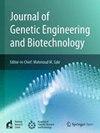铜绿假单胞菌PAC1中假设蛋白质的计算机分析:结构和功能见解
IF 2.8
Q3 Biochemistry, Genetics and Molecular Biology
Journal of Genetic Engineering and Biotechnology
Pub Date : 2025-06-19
DOI:10.1016/j.jgeb.2025.100515
引用次数: 0
摘要
细菌基因组包含许多假设的蛋白质(hp),其作用尚未确定。本研究使用计算方法鉴定和预测铜绿假单胞菌PAC1菌株中这些蛋白的功能。方法分析PAC1基因组(GenBank: CP053706.1),从828个hp开始。短于50个氨基酸的蛋白质(不太可能形成稳定的结构)被排除在外,剩下807个hp。通过评估物理化学性质来过滤不稳定的蛋白质,产生了272个候选蛋白。亚细胞定位工具预测了58种蛋白的细胞质定位。功能注释确定了保守结构域,同源性建模生成了与已知模板相似度为80%的蛋白质3D结构。进行结构验证和活性位点预测以评估生物学相关性。结果WP_003099663.1(186个残基)和WP_010793930.1(455个残基)具有良好的结构稳定性和功能潜力。WP_003099663.1被注释为参与二氧化碳调节的锌依赖性酶,而WP_010793930.1与氨基酸生物合成有关。结构模型证实了稳定的折叠,配体结合位点预测强调了保守区域,提示在代谢途径中起作用。结论本研究展示了一种系统的计算方法来表征细菌基因组中假设的蛋白质。WP_003099663.1和WP_010793930.1具有良好的结构和功能特征,值得进一步的实验研究。本文章由计算机程序翻译,如有差异,请以英文原文为准。
In silico analysis of hypothetical proteins in Pseudomonas aeruginosa PAC1: Structural and functional insights
Background
Bacterial genomes contain numerous hypothetical proteins (HPs) with uncharacterized roles. This study used computational methods to identify and predict the functions of such proteins in the Pseudomonas aeruginosa PAC1 strain.
Methods
The PAC1 genome (GenBank: CP053706.1) was analyzed, starting with 828 HPs. Proteins shorter than 50 amino acids (unlikely to form stable structures) were excluded, leaving 807 HPs. Physicochemical properties were assessed to filter unstable proteins, resulting in 272 candidates. Subcellular localization tools predicted cytoplasmic localization for 58 proteins. Functional annotation identified conserved domains, and homology modeling generated 3D structures for proteins with >80 % similarity to known templates. Structural validation and active site prediction were performed to assess biological relevance.
Results
Two HPs, WP_003099663.1 (186 residues) and WP_010793930.1 (455 residues), exhibited structural stability and functional potential. WP_003099663.1 was annotated as a zinc-dependent enzyme involved in carbon dioxide regulation, while WP_010793930.1 was linked to amino acid biosynthesis. Structural models confirmed stable folds, and ligand-binding site predictions highlighted conserved regions, suggesting roles in metabolic pathways.
Conclusion
This study demonstrates a systematic computational approach for characterizing hypothetical proteins in bacterial genomes. WP_003099663.1 and WP_010793930.1 exhibit promising structural and functional features and warrant further experimental investigation.
求助全文
通过发布文献求助,成功后即可免费获取论文全文。
去求助
来源期刊

Journal of Genetic Engineering and Biotechnology
Biochemistry, Genetics and Molecular Biology-Biotechnology
CiteScore
5.70
自引率
5.70%
发文量
159
审稿时长
16 weeks
期刊介绍:
Journal of genetic engineering and biotechnology is devoted to rapid publication of full-length research papers that leads to significant contribution in advancing knowledge in genetic engineering and biotechnology and provide novel perspectives in this research area. JGEB includes all major themes related to genetic engineering and recombinant DNA. The area of interest of JGEB includes but not restricted to: •Plant genetics •Animal genetics •Bacterial enzymes •Agricultural Biotechnology, •Biochemistry, •Biophysics, •Bioinformatics, •Environmental Biotechnology, •Industrial Biotechnology, •Microbial biotechnology, •Medical Biotechnology, •Bioenergy, Biosafety, •Biosecurity, •Bioethics, •GMOS, •Genomic, •Proteomic JGEB accepts
 求助内容:
求助内容: 应助结果提醒方式:
应助结果提醒方式:


